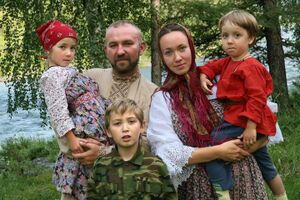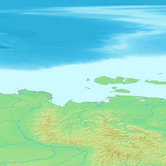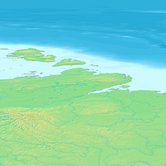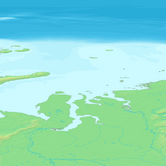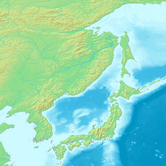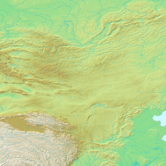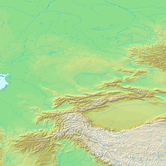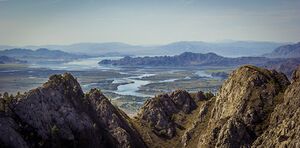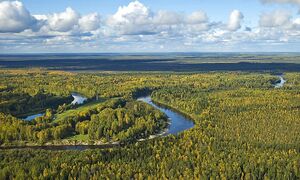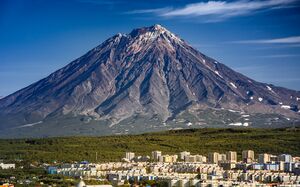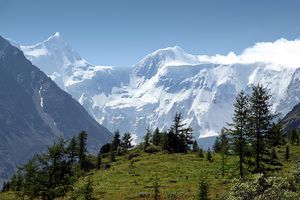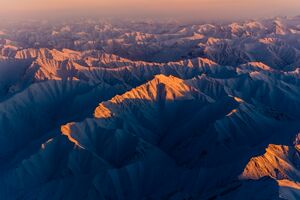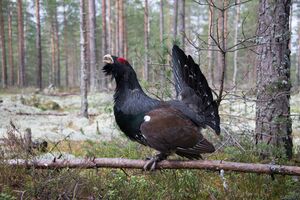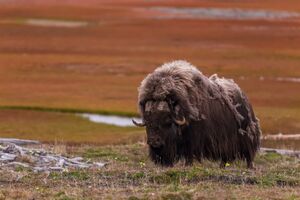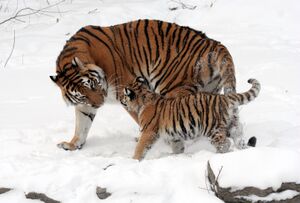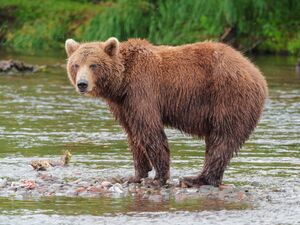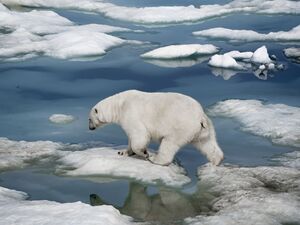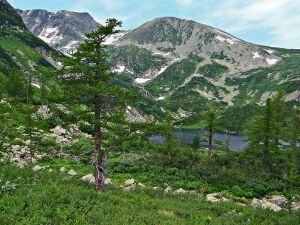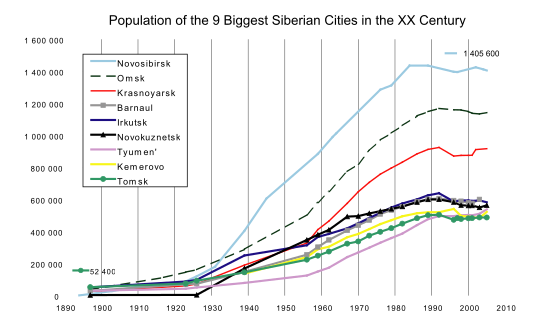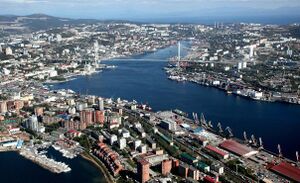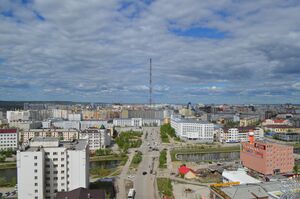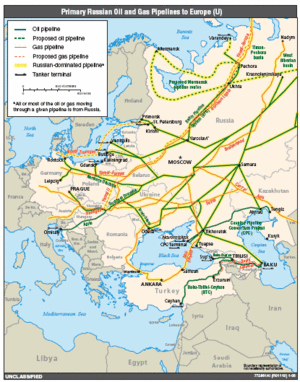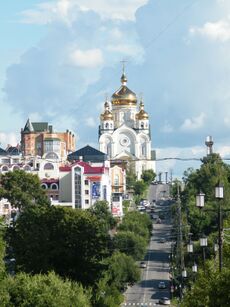سيبيريا
سيبيريا
Сибирь | |
|---|---|
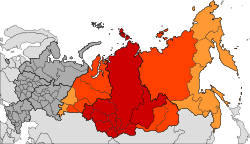 منطقة سيبريا الاتحادية | |
| الإحداثيات: 60°0′N 105°0′E / 60.000°N 105.000°ECoordinates: 60°0′N 105°0′E / 60.000°N 105.000°E | |
| القارة | آسيا |
| البلد | روسيا |
| المناطق | |
| المساحة | |
| • الإجمالي | 13٬100٬000 كم² (5٬100٬000 ميل²) |
| التعداد (2023) | |
| • الإجمالي | 36٫8 مليون[1] |
| • الكثافة | 2٫8/km2 (7/sq mi) |
| صفة المواطن | سيبيريون |
سيبيريا ( /saɪˈbɪəriə/ sy-BEER-ee-ə؛ روسية: Сибирь, romanized: Sibir'، IPA: [sʲɪˈbʲirʲ] (![]() استمع)، إنگليزية: Siberia)، هي منطقة جغرافية واسعة تضم كل شمال آسيا، من جبال الأورال غرباً إلى المحيط الهادئ شرقاً.[2] وقد شكلت جزءًا من الأراضي السيادية روسيا والدول التي سبقتها منذ قرون طويلة غزو سيبيريا، والتي بدأت مع سقوط خانية سيبير في أواخر القرن السادس عشر وانتهت بضم تشوكوتكا عام 1778. تتمتع سيبيريا بمساعة شاسعة وعدد قليل من السكان، وتزيد مساحة عن 13.1 مليون كيلومتر مربع، اكنها تضم خمس سكان روسيا فقط.[3]
استمع)، إنگليزية: Siberia)، هي منطقة جغرافية واسعة تضم كل شمال آسيا، من جبال الأورال غرباً إلى المحيط الهادئ شرقاً.[2] وقد شكلت جزءًا من الأراضي السيادية روسيا والدول التي سبقتها منذ قرون طويلة غزو سيبيريا، والتي بدأت مع سقوط خانية سيبير في أواخر القرن السادس عشر وانتهت بضم تشوكوتكا عام 1778. تتمتع سيبيريا بمساعة شاسعة وعدد قليل من السكان، وتزيد مساحة عن 13.1 مليون كيلومتر مربع، اكنها تضم خمس سكان روسيا فقط.[3]
لأن سيبيريا هي مفهوم جغرافي وتاريخي وليست كيانًا سياسيًا، فلا يوجد تعريف دقيق واحد لحدودها الإقليمية. تقليدياً، تمتد سيبيريا على الأراضي الممتدة من جبال الأورال حتى المحيط الهادئ، وعادة ما يشكل نهر الأورال الجزء الجنوبي من حدودها الغربية، وتشمل معظم حوض تصريف المحيط المتجمد الشمالي. كما تُعرف على أنها تمتد من الأراضي داخل الدائرة القطبية الشمالية في الشمال إلى الحدود الشمالية لقزخستان ومنغوليا والصين في الجنوب، على الرغم من التلال من شمال وسط قزخستان مدرجة أيضًا بشكل شائع.[2][4] تقسم الحكومة الروسية المنطقة إلى ثلاث مناطق اتحادية (تجميع للكيانات الاتحادية الروسية)، لا يُشار رسميًا إلا إلى المنطقة المركزية فقط باسم "سيبيريا "؛ المقاطعتان الأخريان هما منطقة الأورال والشرق الأقصى الاتحادية، المسماة على اسم الأورال والشرق الأقصى الروسي التي تتوافق على التوالي مع الثلثين الغربي والشرقي لسيبيريا بالمعنى الأوسع.
تشتهر سيبيريا في جميع أنحاء العالم بفصول الشتاء الطويلة القاسية، حيث يبلغ متوسط درجات الحرارة في يناير -25 درجة مئوية.[5] على الرغم من أنها تقع جغرافيًا في آسيا إلا أن السيادة والاستعمار الروسي منذ القرن السادس عشر جعلت المنطقة أوروبية ثقافيًا وعرقيًا.[6] أكثر من 85% من سكانها من أصول أوروبية،[7][8] تسود التأثيرات الثقافية الروسية (التي تضم العرقية السيبيرية الفرعية) و لسلافية الشرقية في جميع أنحاء المنطقة.[6] ومع ذلك، توجد أقليات عرقية كبيرة من أصل آسيوي، بما في ذلك تجمعات التوركية المختلفة والتي تشمل الياقوت، التوفان، الألطاي، الخقاس، وهم من السكان الأصليين، جنبًا إلى جنب مع البوريات المنغول والعرقية الكورية والمجموعات الأصغر من شعوب السامويد والتونجوز (تصنف الحكومة الروسية العديد منهم كشعوب أصلية ذات أعداد صغيرة)، بالإضافة إلى الكثير من الشعوب الأخرى.
. . . . . . . . . . . . . . . . . . . . . . . . . . . . . . . . . . . . . . . . . . . . . . . . . . . . . . . . . . . . . . . . . . . . . . . . . . . . . . . . . . . . . . . . . . . . . . . . . . . . . . . . . . . . . . . . . . . . . . . . . . . . . . . . . . . . . . . . . . . . . . . . . . . . . . . . . . . . . . . . . . . . . . . .
التسمية
بعض المصادر تنسب التسمية إلى التوركية وتعني "الأرض النائمة" [9]، وتنسبها مصادر أخرى إلى قبائل التتار التي كانت تعيش في المنطقة.[10] سُجل الاستخدام الحديث للاسم في اللغة الروسية بعد الفتح الروسي لخانية سيبيريا. هناك مصادر أخرى تدعي أن المنطقة سميت على اسم شعب السيب.[11]
التاريخ
ما قبل التاريخ
تشكلت مصاطب سيبيريا نتيجة لواحداً من أكبر الأحداث البركانية المعروفة خلال آخر 251 مليون سنة من التاريخ الجيولوجي للأرض. استمر نشاطها لمليون سنة، ويعتبره بعض العلماء سببًا محتملاً لحدث "الموت العظيم" منذ حوالي 250 مليون سنة،[15] – الذي يُقدر أنه أسفر عن مقتل 90% من الأنواع التي كانت موجودة في ذلك الوقت.[16]
تتمتع المنطقة بأهمية أحفورية، حيث أنها تحتوي على أجسام ما قبل التاريخ لحيوانات من حقبة پلایستوسين، محفوظة في الجليد أو في التربة الصقيعية. عُثر في المنطقة على عينات من أسد الكهف الأوروبي#العينات أشبال أسد كهف الأوروبي، ويوكا الماموث، وآخر وحيد قرن صوفي من أويمياكون، ووحيد قرن صوفي من كوليما وبيسون وحصان من يوكاجير.[17] يُعتقد أن جزيرة رانجل وشبه جزيرة تيمير النائيتين كانتا آخر الأماكن على الأرض التي أوت مجموعات وحيد القرن الصوفي المعزولة حتى انقراضها حوالي عام 2000 ق.م.[18]
عاشت في جنوب سيبيريا ثلاثة أنواع على الأقل من البشر منذ حوالي 40000 سنة: الإنسان العاقل، والنياندرتال و[[ H. سابينس ، ' H. إنسان نياندرتالنسيس ، والدينيسوفان.[19] عام 2010، حددت أدلة الحمض النووي الأخير كنوع منفصل.[20]
يبدو أن السيبيريين الجنوبيين المتأخرين من العصر الحجري القديم مرتبطون بالأوروبيين من العصر الحجري القديم المتأخر وشعب الجنومون الياباني من العصر الحجري القديم.[21] كشف تحليل الحمض النووي القديم أن أقدم أحفورة معروفة تحمل الأليل المشتق KITLG ، المسؤول عن الشعر الأشقر في الأوروبيين المعاصرين، هي عينة أوراسية شمالية قديمة تبلغ من العمر 17000 عام من سيبيريا.[22] كانت المجموعات الأوراسية الشمالية القديمة المتشابهة وراثيًا حيث كانت ثقافة مالتا-بوريت وأفونتوفا جورا مساهماً وراثياً هاماً للأمريكيين والأوروبيين الأصليين، والشعوب الأصلية في آسيا الوسطى وجنوب آسيا وبعض مجموعات شرق آسيا (مثل شعب الأينو). تشير الأدلة من الدراسات الجينومية الكاملة إلى أن الأشخاص الأوائل في الأمريكتين تباعدوا عن شرق آسيا القديم منذ حوالي 36000 عام وتوسعوا شمالًا إلى سيبيريا، حيث واجهوا وتفاعلوا مع سكان شمال أوراسيا القدماء، مما أدى إلى ظهور كل من الشعوب السيبيرية القديمة و الأمريكان الأصليين القدماء، الذين هاجروا لاحقًا نحو منطقة بيرنجيان، أصبحوا معزولين عن السكان الآخرين، وبالتالي سكنوا الأمريكتين.[23][24]
التاريخ المبكر
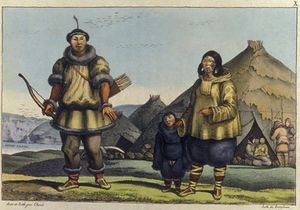
خلال آلاف السنين الماضية، كانت هناك مجموعات مختلفة من الرحل - مثل الإنتس، والننتس، والهون، والشيونج نو، والسكوذيون، واليوغور سكنوا أجزاء مختلفة من سيبيريا. ترتبط ثقافة الأفاناسيڤو والتاشتيك في وادي ينيسي وجبال ألطاي بالهجرات الهندو-أوروپية عبر أوراسيا.[25]
احتل شعب الخيتان المنغولي البدائي أيضًا أجزاء من المنطقة. في القرن الثالث عشر، في عهد الامبراطورية المنغولية، اجتاج المنغول جزءًا كبيرًا من هذه المنطقة.[26]
مع تفكك القبيل الذهبي، تشكلت خانية سيبير ذاتية الحكم في أواخر القرن الخامس عشر. هاجر الياقوت الناطقون بالتوركية شمالًا من بحيرة بايكال تحت ضغط قبائل المنغول خلال القرن الثالث عشر إلى الخامس عشر..[27] ظلت سيبيريا منطقة ذات كثافة سكانية منخفضة. كتب المؤرخ جون ريتشاردز: "... من المشكوك فيه أن إجمالي عدد سكان سيبيريا الحديث المبكر تجاوز 300.000 شخص".[28]
بدأت القوة المتنامية لروسيا في الغرب في تقويض خانات سيبيريا في القرن السادس عشر. أولاً، بدأت مجموعات من التجار والقوزاق في دخول المنطقة. توجه الجيش الروسي لإنشاء حصون أبعد وأبعد شرقاً لحماية المستوطنين الروس الجدد الذين هاجروا من أوروبا. تطورت مدن مثل مانگازيا وتارا وينيسييسك وتوبولسك، وأصبحت الأخيرة العاصمة "الفعلية" لسيبيريا منذ عام 1590. في ذلك الوقت، كان اسم "سيبير" هو اسم قلعة في قشليق، بالقرب من توبولسك. أشار گراردوس مركاتور، في خريطة نُشرت عام 1595، إلى "سيبير" كاسم لمستوطنة وللمنطقة المحيطة بها على امتداد الرافد الأيسر لنهر أوب.[29] تؤكد مصادر أخرى[which?] يؤكدون أن السيب، وهم من الشعوب التونگوسية الأصلية، قاموا التوسع الروسي خارج جبال الأورال بشراسة. يقترح البعض أن مصطلح "سيبيريا" هو إضفاء للطابع الروسي على أسمائهم العرقية.[11]
الامبراطورية الروسية
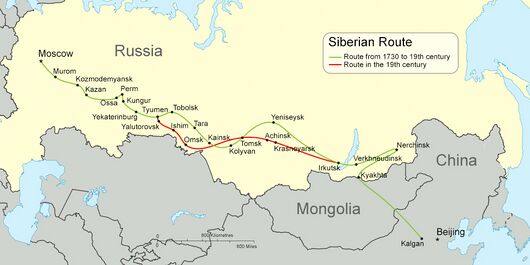
بحلول منتصف القرن السابع عشر، أسست روسيا مناطق سيطرة امتدت حتى المحيط الهادئ. بحلول عام 1709 استقر حوالي 230.00 روسي في سيبيريا.[30] أصبحت سيبيريا إحدى الوجهات لإرسال المنفيين داخلياً. كان المنفى هو الممارسة العقابية الروسية الرئيسية حيث نُفي أكثر من 800.000 شخص خلال القرن التاسع عشر.[31][32]
كان أول تغيير حديث كبير في سيبيريا هو السكك الحديدية العابرة لسيبيريا، التي شُيدت خلال 1891-1916. ربطت هذه السكك الحديدية سيبيريا بشكل أوثق مع روسيا التي سرعان ما تنامى فيها النشاط الصناعي في عهد نيقولاي الثاني (حكم 1894-1917). ما بين عام 1801 و1914 انتقل حوالي سبعة ملايين روسي من أوروبا إلى سيبيريا.[33] بين عامي 1859 و1917 هاجر أكثر من نصف مليون شخص إلى الشرق الأقصى الروسي.[34] تتمتع سيبيريا بموارد طبيعية واسعة النطاق: خلال القرن العشرين، حدث استغلال موسع لهذه الموارد، وظهرت المدن الصناعية في جميع أنحاء المنطقة.[35]
الساعة 7:15 صباحًا. في 30 يونيو 1908 قطع حدث تونگوسكا ملايين الأشجار بالقرب من پودكامينايا تونگوسكا (تونگوسكا الصخرية) في وسط سيبيريا. يعتقد معظم العلماء أن هذا ناتج عن انفجار نيزك أو مذنب في الهواء. على الرغم من عدم العثور على فوهة بركان على الإطلاق، فإن المناظر الطبيعية في المنطقة (قليلة السكان) لا تزال تحمل أثر هذا الحدث.[36]
الاتحاد السوڤيتي
في العقود الأولى من الاتحاد السوڤيتي (خاصة في الثلاثينيات والأربعينيات)، استخدمت الحكومة وكالة الجولاج الحكومية لإدارة معسكرات العمل العقابية، لتحل محل نظام كاتورجا السابق.[37] وفقًا للتقديرات السوڤيتية شبه الرسمية، التي لم تُنشر إلا بعد سقوط الحكومة السوڤيتية عام 1991، من عام 1929 حتى 1953، مر أكثر من 14 مليون شخص عبر هذه المعسكرات والسجون والعديد منهم في سيبيريا. تم ترحيل من سبعة إلى ثمانية ملايين شخص آخر قسرياً إلى مناطق نائية من الاتحاد السوڤيتي (بما في ذلك جنسيات أو أعراق كاملة في عدة حالات).[38]
من عام 1941 حتى 1943 توفي نصف مليون (516.841) سجين في المعسكرات[39] أثناء الحرب العالمية الثانية.[بحاجة لمصدر] في فترات أخرى، كان معدل الوفيات أقل نسبيًا.[40] لا يزال حجم ونطاق معسكرات العمل القسري في الجولاج موضوعًا للكثير من البحث والنقاش. عملت العديد من معسكرات الجولاج في مناطق نائية للغاية في شمال شرق سيبيريا. تضمنت المجموعات الأكثر شهرة "سيڤستولاج" ("مخيمات الشمال الشرقي") على امتداد نهر كوليما و"نوريلاج" بالقرب من نوريلسك، حيث كان يعيش 69.000 سجين عام 1952.[41] المدن الصناعية الرئيسية في شمال سيبيري ، مثل نوريلسك وماغادان، تطورت من معسكرات بناها السجناء ويديرها سجناء سابقون.[42]
الجغرافيا
| خريطة طبيعية لشمال آسيا | ||
|---|---|---|
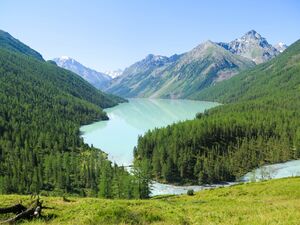
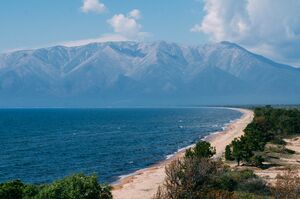
تمتد سيبيريا على مساحة 13.1 مليون كيلومتر مربع، وتغطي الغالبية العظمى من إجمالي أراضي روسيا، وما يقرب من 9% من سطح الأرض (148.940.000 كم 2). جغرافياً تقع سيبيريا في آسيا، لكنها تعتبر أوروبية من الناحية الثقافية والسياسية، لأنها جزء من روسيا.[6] مقع غالبية المناطق الجغرافية في سيبيريا داخل سهل سيبيريا الغربي وهضبة سيبيريا الوسطى.
تتألف سخا الشرقية والوسطى من العديد من السلاسل الجبلية بين الشمال والجنوب من مختلف الأعمار. تمتد هذه الجبال إلى ما يقرب من 3000 متر، لكن الجبال التي يزيد ارتفاعها عن بضع مئات من الأمتار تكون خالية تمامًا من الغطاء النباتي. في العصر الجليدي تعرضت سلسلة جبال ڤيرخويانسك للتجمد واسع النطاق، لكن المناخ كان جافًا جدًا بحيث لم يمتد التجلد إلى الارتفاعات المنخفضة. في هذه المرتفعات المنخفضة يوجد العديد من الوديان، العديد منها عميق ومغطى بغابات الصنوبر، باستثناء أقصى الشمال حيث تهيمن التندرا. التربة هي في الأساس عبارة عن توربيلات (نوع من الجيليسول). تميل الطبقة النشطة إلى أن يكون عمقها أقل من متر واحد، إلا بالقرب من الأنهار.
أعلى نقطة في سيبيريا هي بركان كليتشڤسكايا سوپكا، في شبه جزيرة كامتشاتكا. تصل قمته إلى 4750 م.
. . . . . . . . . . . . . . . . . . . . . . . . . . . . . . . . . . . . . . . . . . . . . . . . . . . . . . . . . . . . . . . . . . . . . . . . . . . . . . . . . . . . . . . . . . . . . . . . . . . . . . . . . . . . . . . . . . . . . . . . . . . . . . . . . . . . . . . . . . . . . . . . . . . . . . . . . . . . . . . . . . . . . . . .
السلاسل الجبلية
المناطق الجيومورفولوجية
البحيرات والأنهار
الأراضي العشبية
- هضبة أوكوك—جزء من أحد مواقع التراث العالمي التابع لليونسكو[43]
الجيولوجيا
The West Siberian Plain, consisting mostly of Cenozoic alluvial deposits, is somewhat flat. In the mid-Pleistocene, many deposits on this plain resulted from ice dams which produced a large glacial lake. This mid- to late-Pleistocene lake blocked the northward flow of the Ob and Yenisey rivers, resulting in a redirection southwest into the Caspian and Aral seas via the Turgai Valley.[44] The area is very swampy, and soils are mostly peaty histosols and, in the treeless northern part, histels. In the south of the plain, where permafrost is largely absent, rich grasslands that are an extension of the Kazakh Steppe formed the original vegetation, most of which is no longer visible.[لماذا؟]
The Central Siberian Plateau is an ancient craton (sometimes named Angaraland) that formed an independent continent before the Permian (see the Siberian continent). It is exceptionally rich in minerals, containing large deposits of gold, diamonds, and ores of manganese, lead, zinc, nickel, cobalt, and molybdenum. Much of the area includes the Siberian Traps—a large igneous province. A massive eruptive period approximately coincided with the Permian–Triassic extinction event. The volcanic event is said[ممن؟] to be the largest known volcanic eruption in Earth's history. Only the extreme northwest was glaciated during the Quaternary, but almost all is under exceptionally deep permafrost, and the only tree that can thrive, despite the warm summers, is the deciduous Siberian Larch (Larix sibirica) with its very shallow roots. Outside the extreme northwest, the taiga is dominant, covering a significant fraction of the entirety of Siberia.[45] Soils here are mainly turbels, giving way to spodosols where the active layer becomes thicker and the ice-content lower.
The Lena-Tunguska petroleum province includes the Central Siberian platform (some authors refer to it as the "Eastern Siberian platform"), bounded on the northeast and east by the Late Carboniferous through Jurassic Verkhoyansk foldbelt, on the northwest by the Paleozoic Taymr foldbelt, and on the southeast, south and southwest by the Middle Silurian to Middle Devonian Baykalian foldbelt.[46] A regional geologic reconnaissance study begun in 1932 and followed by surface and subsurface mapping revealed the Markova-Angara Arch (anticline). This led to the discovery of the Markovo Oil Field in 1962 with the Markovo—1 well, which produced from the Early Cambrian Osa Horizon bar-sandstone at a depth of 2,156 metres (7,073 ft).[46] The Sredne-Botuobin Gas Field was discovered in 1970, producing from the Osa and the Proterozoic Parfenovo Horizon.[46] The Yaraktin Oil Field was discovered in 1971, producing from the Vendian Yaraktin Horizon at depths of up to 1,750 metres (5,740 ft), which lies below Permian to Lower Jurassic basalt traps.[46]
المناخ
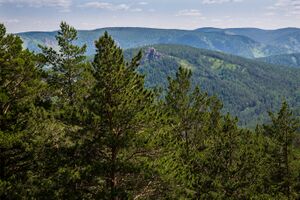

|
|
polar desert
tundra
alpine tundra
taiga
montane forest |
| Vegetation in Siberia mostly consists of taiga, with a tundra belt on the northern fringe, and a temperate forest zone in the south. |
The climate of Siberia varies dramatically, but it typically has short summers and long, brutally cold winters. On the north coast, north of the Arctic Circle, there is a very short (about one month long) summer.
Almost all the population lives in the south, along the route of the Trans-Siberian Railway. The climate in this southernmost part is humid continental climate (Köppen Dfb) with cold winters but fairly warm summers lasting at least four months. The annual average temperature is about 0.5 °C (32.9 °F). January averages about −20 °C (−4 °F) and July about +19 °C (66 °F), while daytime temperatures in summer typically exceed 20 °C (68 °F).[47][48] With a reliable growing season, an abundance of sunshine and exceedingly fertile chernozem soils, southern Siberia is good enough for profitable agriculture, as was demonstrated in the early 20th century.
By far the most commonly occurring climate in Siberia is continental subarctic (Koppen Dfc or Dwc), with the annual average temperature about −5 °C (23 °F) and an average for January of −25 °C (−13 °F) and an average for July of +17 °C (63 °F),[49] although this varies considerably, with a July average about 10 °C (50 °F) in the taiga–tundra ecotone. The business-oriented website and blog Business Insider lists Verkhoyansk and Oymyakon, in Siberia's Sakha Republic, as being in competition for the title of the Northern Hemisphere's Pole of Cold. Oymyakon is a village which recorded a temperature of −67.7 °C (−89.9 °F) on 6 February 1933. Verkhoyansk, a town further north and further inland, recorded a temperature of −69.8 °C (−93.6 °F) for three consecutive nights: 5, 6 and 7 February 1933. Each town is alternately considered the Northern Hemisphere's Pole of Cold – the coldest inhabited point in the Northern hemisphere. Each town also frequently reaches 30 °C (86 °F) in the summer, giving them, and much of the rest of Russian Siberia, the world's greatest temperature-variation between summer's highs and winter's lows, often well over 94–100+ °C (169–180+ °F) between the seasons.[50][المصدر لا يؤكد ذلك]
Southwesterly winds bring warm air from Central Asia and the Middle East. The climate in West Siberia (Omsk, or Novosibirsk) is several degrees warmer than in the East (Irkutsk, or Chita) where in the north an extreme winter subarctic climate (Köppen Dfd or Dwd) prevails. But summer temperatures in other regions can reach +38 °C (100 °F). In general, Sakha is the coldest Siberian region, and the basin of the Yana has the lowest temperatures of all, with permafrost reaching 1,493 metres (4,898 ft). Nevertheless, Imperial Russian plans of settlement never viewed cold as an impediment. In the winter, southern Siberia sits near the center of the semi-permanent Siberian High, so winds are usually light in the winter.
Precipitation in Siberia is generally low, exceeding 500 millimetres (20 in) only in Kamchatka, where moist winds flow from the Sea of Okhotsk onto high mountains – producing the region's only major glaciers, though volcanic eruptions and low summer temperatures allow only limited forests to grow. Precipitation is high also in most of Primorye in the extreme south, where monsoonal influences can produce quite heavy summer rainfall.
| بيانات مناخ Novosibirsk, Siberia's largest city | |||||||||||||
|---|---|---|---|---|---|---|---|---|---|---|---|---|---|
| الشهر | يناير | فبراير | مارس | أبريل | مايو | يونيو | يوليو | أغسطس | سبتمبر | اكتوبر | نوفمبر | ديسمبر | العام |
| العظمى المتوسطة °س (°ف) | −12.2 (10) |
−10.3 (13.5) |
−2.6 (27.3) |
8.1 (46.6) |
17.5 (63.5) |
24.0 (75.2) |
25.7 (78.3) |
22.2 (72) |
16.6 (61.9) |
6.8 (44.2) |
−2.9 (26.8) |
−8.9 (16) |
7٫0 (44٫6) |
| المتوسط اليومي °س (°ف) | −16.2 (2.8) |
−14.7 (5.5) |
−7.2 (19) |
3.2 (37.8) |
11.6 (52.9) |
18.2 (64.8) |
20.2 (68.4) |
17.0 (62.6) |
11.5 (52.7) |
3.4 (38.1) |
−6.0 (21) |
−12.7 (9.1) |
2٫4 (36٫3) |
| الصغرى المتوسطة °س (°ف) | −20.1 (-4.2) |
−19.1 (-2.4) |
−11.8 (10.8) |
−1.7 (28.9) |
5.6 (42.1) |
12.3 (54.1) |
14.7 (58.5) |
11.7 (53.1) |
6.4 (43.5) |
0.0 (32) |
−9.1 (15.6) |
−16.4 (2.5) |
−2٫3 (27٫9) |
| هطول mm (inches) | 19 (0.75) |
14 (0.55) |
15 (0.59) |
24 (0.94) |
36 (1.42) |
58 (2.28) |
72 (2.83) |
66 (2.6) |
44 (1.73) |
38 (1.5) |
32 (1.26) |
24 (0.94) |
442 (17٫4) |
| Source: [51] | |||||||||||||
. . . . . . . . . . . . . . . . . . . . . . . . . . . . . . . . . . . . . . . . . . . . . . . . . . . . . . . . . . . . . . . . . . . . . . . . . . . . . . . . . . . . . . . . . . . . . . . . . . . . . . . . . . . . . . . . . . . . . . . . . . . . . . . . . . . . . . . . . . . . . . . . . . . . . . . . . . . . . . . . . . . . . . . .
الاحترار العالمي
Researchers, including Sergei Kirpotin at Tomsk State University and Judith Marquand at Oxford University, warn that Western Siberia has begun to thaw as a result of global warming. The frozen peat bogs in this region may hold billions of tons of methane gas, which may be released into the atmosphere. Methane is a greenhouse gas 22 times more powerful than carbon dioxide.[52] In 2008 a research expedition for the American Geophysical Union detected levels of methane up to 100 times above normal in the atmosphere above the Siberian Arctic, likely the result of methane clathrates being released through holes in a frozen "lid" of seabed permafrost around the outfall of the Lena and the area between the Laptev Sea and East Siberian Sea.[53][54]
Since 1988, experimentation at Pleistocene Park has proposed to restore the grasslands of prehistoric times by conducting research on the effects of large herbivores on permafrost, suggesting that animals, rather than climate, maintained the past ecosystem. The nature reserve park also conducts climatic research on the changes expected from the reintroduction of grazing animals or large herbivores, hypothesizing that a transition from tundra to grassland would lead to a net change in energy emission to absorption ratios.[55]
According to Vasily Kryuchkov, approximately 31,000 square kilometers of the Russian Arctic has subjected to severe environmental disturbance.
الحياة الحيوانية
الطيور
رتبة Galliformes
فصيلة Tetraonidae
- Hazel grouse[56]
- Siberian grouse[57]
- Black grouse[58]
- Black-billed capercaillie[59]
- Western capercaillie[60]
- Willow ptarmigan[61]
- Rock ptarmigan[62]
فصيلة Phasianidae
الثدييات
رتبة Artiodactyla
- Moose
- Bactrian camel
- Wisent (European bison)
- Red deer
- Wild boar
- Siberian roe deer
- Manchurian wapiti[63]
- Siberian musk deer[64]
رتبة Carnivora
فصيلة Canidae
فصيلة Felidae
فصيلة Mustelidae
- Least weasel
- Stoat
- Mountain weasel
- Siberian weasel
- Steppe polecat
- Sable
- Eurasian river otter
- Asian badger
- Wolverine
فصيلة Ursidae
الحياة النباتية
السياسة
أكبر الدويلات السيادية في سيبيريا
- دولة شيانبـِيْ (القرن 1-3)
- الخاقانية التوركية الأولى (القرن 6-7)
- الخاقانية التوركية الشرقية (القرن 7)
- الخاقانية التوركية الثانية (القرن 7-8)
- الامبراطورية المنغولية (القرن 13-14)
- خانية سيبير (1468–1598)
- قيصرية روسيا (1598–1721)
- الامبراطورية الروسية (1721–1917)
- الجمهورية الروسية (1917–1918)
- جمهورية روسيا الاشتراكية الاتحادية السوڤيتية (1918–1922)
- جمهورية الشرق الأقصى (1920–1922)
- جمهورية توڤا الشعبية (1921–1944)
- الاتحاد السوڤيتي (1922–1991)
- جمهورية روسيا الاشتراكية الاتحادية السوڤيتية (1922–1991)
- روسيا الاتحادية (1991–الحاضر)
الحدود والتقسيمات الإدارية
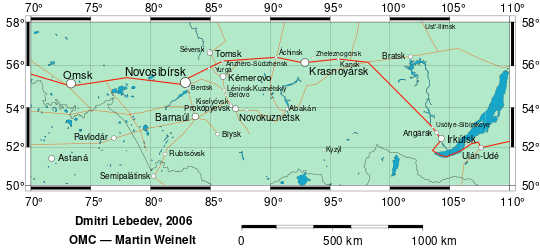
The term "Siberia" has both a long history and wide significance, and association. The understanding, and association of "Siberia" have gradually changed during the ages. Historically, Siberia was defined as the whole part of Russia and North Kazakhstan to the east of Ural Mountains, including the Russian Far East. According to this definition, Siberia extended eastward from the Ural Mountains to the Pacific coast, and southward from the Arctic Ocean to the border of Central Asia and the national borders of both Mongolia and China.[71]
Soviet-era sources (Great Soviet Encyclopedia and others)[4] and modern Russian ones[72] usually define Siberia as a region extending eastward from the Ural Mountains to the watershed between Pacific and Arctic drainage basins, and southward from the Arctic Ocean to the hills of north-central Kazakhstan and the national borders of both Mongolia and China. By this definition, Siberia includes the federal subjects of the Siberian Federal District, and some of the Ural Federal District, as well as Sakha (Yakutia) Republic, which is a part of the Far Eastern Federal District. Geographically, this definition includes subdivisions of several other subjects of Urals and Far Eastern federal districts, but they are not included administratively. This definition excludes Sverdlovsk Oblast and Chelyabinsk Oblast, both of which are included in some wider definitions of Siberia.
Other sources may use either a somewhat wider definition that states the Pacific coast, not the watershed, is the eastern boundary (thus including the whole Russian Far East), as well as all Northern Kazakhstan is its subregion in the south-west[2] or a somewhat narrower one that limits Siberia to the Siberian Federal District (thus excluding all subjects of other districts).[73] In Russian, 'Siberia' is commonly used as a substitute for the name of the federal district by those who live in the district itself, but less commonly used to denote the federal district by people residing outside of it. Due to the different interpretations of Siberia, starting from Tyumen, to Chita, the territory generally defined as 'Siberia', some people will define themselves as 'Siberian', while others not.
A number of factors in recent years, including the fomenting of 'Siberian separatism' have made the definition of the territory of Siberia a potentially controversial subject.[74] In the eastern extent of Siberia there are territories which are not clearly defined as either Siberia or the Far East, making the question of 'what is Siberia?' one with no clear answer, and what is a 'Siberian', one of self-identification.[75]
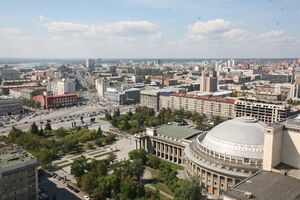
المدن الرئيسية
The most populous city of Siberia, as well as the third most populous city of Russia, is the city of Novosibirsk. Present-day Novosibirsk is an important business, science, manufacturing and cultural center of the Asian part of Russia.
Omsk played an important role in the Russian Civil War serving as a provisional Russian capital, as well in the expansion into and governing of Central Asia. In addition to its cultural status, it has become a major oil-refining, education, transport and agriculture hub.
Other historic cities of Siberia include Tobolsk (the first capital and the only kremlin in Siberia), Tomsk (formerly a wealthy merchant's town) and Irkutsk (former seat of Eastern Siberia's governor general, near lake Baikal).
Other major cities include: Barnaul, Kemerovo, Krasnoyarsk, Novokuznetsk, Tyumen.
Wider definitions of geographic Siberia also include the cities of: Chelyabinsk and Yekaterinburg in the Urals, Khabarovsk and Vladivostok in the Russian Far East, and even Petropavlovsk in Kazakhstan and Harbin in China.
الاقتصاد
Novosibirsk is the largest by population and the most important city for the Siberian economy; with an extra boost since 2000 when it was designated a regional center for the executive bureaucracy (Siberian Federal District). Omsk is a historic and currently the second largest city in the region, and since 1950s hosting Russia's largest oil refinery.
Siberia is extraordinarily rich in minerals, containing ores of almost all economically valuable metals. It has some of the world's largest deposits of nickel, gold, lead, coal, molybdenum, gypsum, diamonds, diopside, silver and zinc, as well as extensive unexploited resources of oil and natural gas.[76] Around 70% of Russia's developed oil fields are in the Khanty-Mansiysk region.[77] Russia contains about 40% of the world's known resources of nickel at the Norilsk deposit in Siberia. Norilsk Nickel is the world's biggest nickel and palladium producer.[78]
Siberian agriculture is severely restricted by the short growing season of most of the region. However, in the southwest where soils consist of exceedingly fertile black earths and the climate is a little more moderate, there is extensive cropping of wheat, barley, rye and potatoes, along with the grazing of large numbers of sheep and cattle. Elsewhere food production, owing to the poor fertility of the podzolic soils and the extremely short growing seasons, is restricted to the herding of reindeer in the tundra—which has been practiced by natives for over 10,000 years.[بحاجة لمصدر] Siberia has the world's largest forests. Timber remains an important source of revenue, even though many forests in the east have been logged much more rapidly than they are able to recover. The Sea of Okhotsk is one of the two or three richest fisheries in the world owing to its cold currents and very large tidal ranges, and thus Siberia produces over 10% of the world's annual fish catch, although fishing has declined somewhat since the collapse of the USSR in 1991.[79]
Reported in 2009, the development of renewable energy in Russia is held back by the lack of a conducive government policy framework,[80][needs update] اعتبارا من 2011[تحديث], Siberia still offers special opportunities for off-grid renewable energy developments. Remote parts of Siberia are too costly to connect to central electricity and gas grids, and have therefore historically been supplied with costly diesel, sometimes flown in by helicopter. In such cases renewable energy is often cheaper.[81]
In 2020 the gross regional product of Siberia was 26.7 trillion ₽ or around US$400 billion.[82]
الرياضة
The Yenisey Krasnoyarsk basketball team has played in the VTB United League since 2011–12.
Russia's third most popular sport, bandy,[83] is important in Siberia. In the 2015–16 Russian Bandy Super League season Yenisey from Krasnoyarsk became champions for the third year in a row by beating Baykal-Energiya from Irkutsk in the final.[84][85] Two or three more teams (depending on the definition of Siberia) play in the Super League, the 2016–17 champions SKA-Neftyanik from Khabarovsk as well as Kuzbass from Kemerovo and Sibselmash from Novosibirsk. In 2007 Kemerovo got Russia's first indoor arena specifically built for bandy.[86] Now Khabarovsk has the world's largest indoor arena specifically built for bandy, Arena Yerofey.[87] It was venue for Division A of the 2018 World Championship. In time for the 2020 World Championship, an indoor arena will be ready for use in Irkutsk. That one will also have a speed skating oval.[88]
The 2019 Winter Universiade was hosted by Krasnoyarsk.
الديموغرافيا
| العرقية | السكان | % |
|---|---|---|
| Slavic | 18,235,471 | 86.2% |
| Turkic | 1,704,665 | 8.1% |
| Mongol | 454,312 | 2.1% |
| Uralic | 131,430 | 0.6% |
| Other | 637,992 | 3.0% |
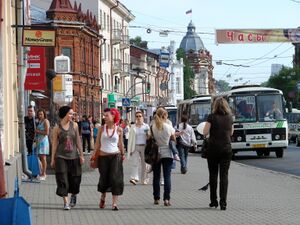
According to the Russian Census of 2010, the Siberian and Far Eastern Federal Districts, located entirely east of the Ural Mountains, together have a population of about 25.6 million. Tyumen and Kurgan Oblasts, which are geographically in Siberia but administratively part of the Urals Federal District, together have a population of about 4.3 million. Thus, the whole region of Siberia (in the broadest usage of the term) is home to approximately 30 million people.[91] It has a population density of about three people per square kilometre.
The largest ethnic group in Siberia is Slavic-origin Russians, including their sub-ethnic group Siberians, and russified Ukrainians.[92] Slavic and other Indo-European ethnicities make up the vast majority (over 85%) of the Siberian population. There are also other groups of indigenous Siberian and non-indigenous ethnic origin. A minority of the current population are descendants of Mongol or Turkic people (mainly Buryats, Yakuts, Tuvans, Altai and Khakas) or northern indigenous people. Slavic-origin Russians outnumber all of the indigenous peoples combined, except in the Republics of Tuva and Sakha.
According to the 2002 census there are 500,000 Tatars in Siberia, but of these, 300,000 are Volga Tatars who also settled in Siberia during periods of colonization and are thus also non-indigenous Siberians, in contrast to the 200,000 Siberian Tatars which are indigenous to Siberia.[93] Of the indigenous Siberians, the Mongol-speaking Buryats, numbering approximately 500,000, are the most numerous group in Siberia, and they are mainly concentrated in their homeland, the Buryat Republic.[94] According to the 2010 census there were 478,085 indigenous Turkic-speaking Yakuts.[95] Other ethnic groups indigenous to Siberia include Kets, Evenks, Chukchis, Koryaks, Yupiks, and Yukaghirs.
About seventy percent of Siberia's people live in cities, mainly in apartments.[96] Many people also live in rural areas, in simple, spacious, log houses. Novosibirsk[97] is the largest city in Siberia, with a population of about 1.6 million. Tobolsk, Tomsk, Tyumen, Krasnoyarsk, Irkutsk, and Omsk are the older, historical centers.
الديانات
There are a variety of beliefs throughout Siberia, including Orthodox Christianity, other denominations of Christianity, Tibetan Buddhism and Islam.[98] The Siberian Federal District alone has an estimation of 250,000 Muslims. An estimated 70,000 Jews live in Siberia,[99] some in the Jewish Autonomous Region.[100] The predominant religious group is the Russian Orthodox Church.
Tradition regards Siberia the archetypal home of shamanism, and polytheism is popular.[101] These native sacred practices are considered by the tribes to be very ancient. There are records of Siberian tribal healing practices dating back to the 13th century.[102] The vast territory of Siberia has many different local traditions of gods. These include: Ak Ana, Anapel, Bugady Musun, Kara Khan, Khaltesh-Anki, Kini'je, Ku'urkil, Nga, Nu'tenut, Num-Torum, Pon, Pugu, Todote, Toko'yoto, Tomam, Xaya Iccita and Zonget. Places with sacred areas include Olkhon, an island in Lake Baikal.
النقل
Many cities in northern Siberia, such as Petropavlovsk-Kamchatsky, cannot be reached by road, as there are virtually none connecting from other major cities in Russia or Asia. Siberia can be reached through the Trans-Siberian Railway. The Trans-Siberian Railway operates from Moscow in the west to Vladivostok in the east. Cities that are located far from the railway are reached by air or by the separate Baikal–Amur Railway (BAM).
الثقافة
المطبخ
الستروگانينا هو طبق سمك نيء يشتهر به السكان الأصليون في سيبيريا القطبية الشمالية مصنوع من الأسماك المجمدة النيئة الرقيقة المقطعة إلى شرائح طويلة.[103] It is a popular dish with native Siberians.[104] تشتهر سيبيريا أيضًا بزلابية البلميني؛ التي يتم تجميدها تقليديًا وتخزينها في الهواء الطلق بفصل الشتاء. بالإضافة إلى ذلك، هناك العديد من أطباق التوت والجوز والفطر التي تستفيد من ثروات الطبيعة الوفيرة.
انظر أيضاً
المصادر
- ^ "Предварительная оценка численности постоянного населения на 1 января 2023 г." Federal State Statistics Service. Retrieved 21 February 2023.
- ^ أ ب ت "Siberia". Encyclopædia Britannica Online. Retrieved 2021-09-22.
- ^ "The Largest Cities in Siberia".
- ^ أ ب Сибирь — Большая советская энциклопедия (The Great Soviet Encyclopedia, in Russian)
- ^ "Arctic Oscillation and Polar Vortex Analysis and Forecasts". Atmospheric and Environmental Research, Verisk Analytics. Retrieved 20 May 2018.
- ^ أ ب ت Haywood, A. J. (2010). Siberia: A Cultural History (in الإنجليزية). Oxford University Press. ISBN 9780199754182.
- ^ "ВПН-2010". Perepis-2010.ru (in الروسية). Archived from the original on 2012-01-18. Retrieved 2016-04-03.
- ^ "ВПН-2010". Gks.ru (in الروسية). Archived from the original on 15 March 2013. Retrieved 2016-04-03.
- ^ Healing oils from pristine Siberian wilderness
- ^ "Siberia".
- ^ أ ب Crossley, Pamela Kyle (2002). The Manchus. Peoples of Asia. Vol. 14 (3rd ed.). Wiley-Blackwell. p. 213. ISBN 978-0-631-23591-0. Retrieved 28 December 2013.
- ^ Pankova, Svetlana; Simpson, St John (21 January 2021). Masters of the Steppe: The Impact of the Scythians and Later Nomad Societies of Eurasia: Proceedings of a conference held at the British Museum, 27–29 October 2017 (in الإنجليزية). Archaeopress Publishing Ltd. pp. 218–219. ISBN 978-1-78969-648-6.
Inv. nr.Si. 1727- 1/69, 1/70
- ^ Francfort, Henri-Paul (1 January 2020). "Sur quelques vestiges et indices nouveaux de l'hellénisme dans les arts entre la Bactriane et le Gandhāra (130 av. J.-C.-100 apr. J.-C. environ)". Journal des Savants (in الإنجليزية): 37.
- ^ Ollermann, Hans (22 August 2019). "Belt Plaque with a Bear Hunt. From Russia (Siberia). Gold. 220-180 B.C. The State Hermitage Museum, St. Petersburg, Russia".
- ^ "Yellowstone's Super Sister". Archived from the original on 14 March 2005. Retrieved 17 April 2010.
[...] the Siberian Traps is the prime suspect in wiping out 90 percent of all living species 251 million years ago – the most severe extinction event in Earth's history.
. Discovery Channel. - ^ Benton, M. J. (2005). When Life Nearly Died: The Greatest Mass Extinction of All Time. Thames & Hudson. ISBN 978-0-500-28573-2.[need quotation to verify]
- ^ "Meet this extinct cave lion, at least 10,000 years old – world exclusive". siberiantimes.com. Retrieved 30 January 2016.
- ^ Wang, Y; Pedersen, M.W.; Alsos, I.g.; et al. (2021). "Late Quaternary dynamics of Arctic biota from ancient environmental genomics". Nature. 600 (7887): 86–92. Bibcode:2021Natur.600...86W. doi:10.1038/s41586-021-04016-x. PMC 8636272. PMID 34671161.
- ^ " DNA identifies new ancient human dubbed 'X-woman'," BBC News. 25 March 2010.
- ^ Richards, Michael P. (2020). Archaeological Science. Cambridge University Press. p. 23. ISBN 9780521195225.
In early 2010, researchers published a complete mitochondrial genome sequence retrieved from a hominin excavated from the Denisova cave in Siberia....The results demonstrated that the Denisovan lineage diverged early from the modern humans and Neanderthals
- ^ "Jomon Culture and the peopling of the Japanese archipelago: advancements in the fields of morphometrics and ancient DNA". ResearchGate (in الإنجليزية). Retrieved 2019-08-18.
- ^ Evans, Gavin (2019). Skin Deep: Dispelling the Science of Race (1 ed.). Simon and Schuster. p. 139. ISBN 9781786076236.|
- ^ Raff, Jennifer (2020-06-09). Origin: A Genetic History of the Americas (in الإنجليزية الأمريكية). ISBN 978-1-5387-4971-5.
- ^ Sapiens (2022-02-08). "A Genetic Chronicle of the First Peoples in the Americas". SAPIENS (in الإنجليزية الأمريكية). Retrieved 2022-10-29.
- ^ Gibbons, Ann (10 June 2015). "Nomadic herders left a strong genetic mark on Europeans and Asians". Science. AAAS.
- ^
Naumov, Igor V. (2006). "The Mongols in Siberia". In Collins, David Norman (ed.). The History of Siberia. Routledge Studies in the History of Russia and Eastern Europe. Translated by Collins, David Norman. London: Routledge. p. 44. ISBN 9781134207039. Retrieved 11 June 2019.
In 1207 Chinggis Khan sent his troops north under the command of his elder son Jochi to subjugate the 'forest peoples'. Jochi was able to do so in the space of three years. The only exception was the remote northern tribes. Most of Siberia became part of the Mongol Empire.
- ^ قالب:Citation-attribution
- ^ Richards, 2003 p. 538.
- ^ Asia ex magna Orbis terrae descriptione Gerardi Mercatoris desumpta, studio & industria G.M. Iunioris
- ^ Sean C. Goodlett. "Russia's Expansionist Policies I. The Conquest of Siberia". Falcon.fsc.edu. Archived from the original on 11 مايو 2011. Retrieved 15 مايو 2010.
- ^ For example: Prison without a roof
- ^
Barker, Adele Marie (2010). Barker, Adele Marie; Grant, Bruce (eds.). The Russia Reader: History, Culture, Politics. The World Readers. Durham, North Carolina: Duke University Press. p. 441. ISBN 9780822346487. Retrieved 11 June 2019.
Throughout Russian history there is a long-standing tradition of imprisoning and sentencing to internal exile (within the country proper) political and religious dissidents. [...] Among those sentenced to internal exile were [...] the Decembrists [...]. Several were executed; others were exiled to Siberia, the Far East, and Kazakhstan.
- ^ Fisher, Raymond H.; Treadgold, Donald W. (1958). "Review: The Great Siberian Migration: Government and Peasant in Resettlement from Emancipation to the First World War". The American Historical Review. 63 (4): 989–990. doi:10.2307/1848991. JSTOR 1848991.
- ^ The Russian Far East: A History. John J. Stephan (1996). Stanford University Press. p.62. ISBN 0-8047-2701-5
- ^ Fiona Hill, Russia — Coming In From the Cold? Archived 24 أبريل 2013 at the Wayback Machine, The Globalist, 23 February 2004.
- ^ Farinella, Paolo; Foschini, L.; Froeschlé, Christiane; Gonczi, R.; Jopek, T. J.; Longo, G.; Michel, Patrick (2001). "Probable asteroidal origin of the Tunguska Cosmic Body" (PDF). Astronomy & Astrophysics. 377(3): 1081–1097. Bibcode:2001A&A...377.1081F. DOI:10.1051/0004-6361:20011054.
- ^ The Unknown Gulag: The Lost World of Stalin's Special Settlements. Lynne Viola (2007). Oxford University Press US. p.3. ISBN 0-19-518769-5
- ^ Robert Conquest in "Victims of Stalinism: A Comment," Europe-Asia Studies, Vol. 49, No. 7 (Nov. 1997), pp. 1317–1319 states: "We are all inclined to accept the Zemskov totals (even if not as complete) with their 14 million intake to Gulag 'camps' alone, to which must be added four to five million going to Gulag 'colonies', to say nothing of the 3.5 million already in, or sent to, 'labour settlements'. However taken, these are surely 'high' figures."
- ^ Zemskov, "Gulag," Sociologičeskije issledovanija, 1991, No. 6, pp. 14–15.
- ^ Stéphane Courtois, Mark Kramer. Livre noir du Communisme: crimes, terreur, répression. Harvard University Press, 1999. p. 206. ISBN 0-674-07608-7 – "300,000 known deaths in the camps from 1934 to 1940."
- ^ Courtois and Kramer (1999), Livre noir du Communisme, p.239.
- ^
Chamberlain, Lesley (27 April 2003). "Dark side of the moon". Arlindo-correia.org. Retrieved 11 June 2019.
Today's major industrial cities of Noril'sk, Vorkuta, Kolyma and Magadan, were camps originally built by prisoners and run by ex-prisoners.
- ^ "Altai: Saving the Pearl of Siberia". Pacific Environment. Archived from the original on 22 March 2007. Retrieved 30 November 2006.
- ^ Lioubimtseva E.U., Gorshkov S.P. & Adams J.M.; A Giant Siberian Lake During the Last Glacial: Evidence and Implications; Oak Ridge National laboratory Archived 13 ديسمبر 2006 at the Wayback Machine
- ^ C. Michael Hogan. 2011. Taiga. eds. M.McGinley & C.Cleveland. Encyclopedia of Earth. National Council for Science and the Environment. Washington DC
- ^ أ ب ت ث Meyerhof, A. A., 1980, "Geology and Petroleum Fields in Proterozoic and Lower Cambrian Strata, Lena-Tunguska Petroleum Province, Eastern Siberia, USSR", in Giant Oil and Gas Fields of the Decade: 1968–1978, AAPG Memoir 30, Halbouty, M. T., editor, Tulsa: American Association of Petroleum Geologists, ISBN 0891813063
- ^ "Novosibirsk climate". Worldclimate.com. 4 February 2007. Retrieved 15 May 2010.
- ^ "Omsk climate". Worldclimate.com. 4 February 2007. Retrieved 15 May 2010.
- ^ "Kazachengoye climate". Worldclimate.com. 4 February 2007. Retrieved 15 May 2010.
- ^ Badkar, Mamta (6 February 2014). "This Tiny Town In Russia Is The Most Miserable Place In The World". Business Insider. Retrieved 28 August 2021.
- ^ Гидрометцентр России (in الروسية). Archived from the original on 27 June 2008. Retrieved 8 January 2009.
- ^ Ian Sample, "Warming hits 'tipping point'". The Guardian, 11 August 2005.
- ^ Connor, Steve (23 September 2008). "Exclusive: The methane time bomb". The Independent. Retrieved 3 October 2008.
- ^ N. Shakhova, I. Semiletov, A. Salyuk, D. Kosmach, and N. Bel'cheva (2007), Methane release on the Arctic East Siberian shelf, Geophysical Research Abstracts, 9, 01071.
- ^ Sergey A. Zimov (6 May 2005): "Pleistocene Park: Return of the mammoths' ecosystem" In: Science, pages 796–798. Article also to be found in www.pleistocenepark.ru/en/ – Materials. Archived 3 نوفمبر 2016 at the Wayback Machine Retrieved 5 May 2013.
- ^ "Northern Hazelhen (Tetrastes bonasia). Photo Gallery.Birds of Siberia". sibirds.ru. Retrieved 18 June 2020.
- ^ "Siberian Grouse (Falcipennis falcipennis). Photo Gallery.Birds of Russian Far East". fareastru.birds.watch. Retrieved 18 June 2020.
- ^ "Northern Black Grouse (Lyrurus tetrix). Photo Gallery.Birds of Siberia". sibirds.ru. Retrieved 18 June 2020.
- ^ "Black-billed Capercaillie (Tetrao urogalloides). Photo Gallery.Birds of Siberia". sibirds.ru. Retrieved 18 June 2020.
- ^ "Western Capercaillie (Tetrao urogallus). Photo Gallery.Birds of Siberia". sibirds.ru. Retrieved 18 June 2020.
- ^ "Willow Ptarmigan (Lagopus lagopus). Photo Gallery.Birds of Siberia". sibirds.ru. Retrieved 18 June 2020.
- ^ "Rock Ptarmigan (Lagopus muta). Photo Gallery.Birds of Siberia". sibirds.ru. Retrieved 18 June 2020.
- ^ Valerius Geist (January 1998). Deer of the World: Their Evolution, Behaviour, and Ecology. Stackpole Books. p. 211. ISBN 978-0-8117-0496-0. Retrieved 30 January 2016.
- ^ Nyambayar, B.; Mix, H.; Tsytsulina, K. (2015). "Moschus moschiferus". IUCN Red List of Threatened Species. 2015: e.T13897A61977573. doi:10.2305/IUCN.UK.2015-2.RLTS.T13897A61977573.en. Retrieved 12 November 2021. Database entry includes a brief justification of why this species is of vulnerable.
- ^ Uphyrkina, O.; Miquelle, D.; Quigley, H.; Driscoll, C.; O'Brien, S. J. (2002). "Conservation Genetics of the Far Eastern Leopard (Panthera pardus orientalis)" (PDF). Journal of Heredity. 93 (5): 303–11. doi:10.1093/jhered/93.5.303. PMID 12547918. Archived from the original (PDF) on 4 February 2016. Retrieved 30 January 2016.
- ^ Miquelle, D.; Darman, Y.; Seryodkin, I (2011). "Panthera tigris ssp. altaica". IUCN Red List of Threatened Species. 2011: e.T15956A5333650. doi:10.2305/IUCN.UK.2011-2.RLTS.T15956A5333650.en. Retrieved 12 November 2021.
- ^ Garshelis, D.; Steinmetz, R. (2020). "Ursus thibetanus". IUCN Red List of Threatened Species. 2020: e.T22824A166528664. doi:10.2305/IUCN.UK.2020-3.RLTS.T22824A166528664.en. Retrieved 12 November 2021.
- ^ McLellan, B.N.; Proctor, M.F.; Huber, D.; Michel, S. (2017). "Ursus arctos". IUCN Red List of Threatened Species. 2017: e.T41688A121229971. doi:10.2305/IUCN.UK.2017-3.RLTS.T41688A121229971.en. Retrieved 12 November 2021.
- ^ Farjon, A. (2013). "Pinus pumila". IUCN Red List of Threatened Species. 2013: e.T42405A2977712. doi:10.2305/IUCN.UK.2013-1.RLTS.T42405A2977712.en.
- ^ A. Farjon (2013). "Picea obovata". IUCN Red List of Threatened Species. 2013: e.T42331A2973177. doi:10.2305/IUCN.UK.2013-1.RLTS.T42331A2973177.en.
- ^ Малый энциклопедический словарь Брокгауза и Ефрона (The Brockhaus and Efron Encyclopedic Dictionary, in Russian)
- ^ Сибирь- Словарь современных географических названий (in Russian)
- ^ "Siberia". Archived from the original on 24 August 2000. Retrieved 4 June 2008., The Columbia Encyclopedia, Sixth Edition
- ^ "Siberian separatism: whether federal center can hold remote regions – Robert Lansing Institute". lansinginstitute.org (in الإنجليزية). 27 October 2020. Retrieved 2022-06-22.
{{cite web}}: CS1 maint: url-status (link) - ^ Douglas Causey. "Russian Far East – Siberia Class". www.siberiaclass.org. Archived from the original (Lecture) on 2021-10-20.
- ^ Statistics on the Development of Gas Fields in Western Siberia, Daily Questions on Energy and Economy
- ^ Schlindwein, Simone (26 August 2008). "The City Built on Oil: EU-Russia Summit Visits Siberia's Boomtown". Spiegel Online. Spiegel. Retrieved 8 August 2014.
- ^ "Norilsk raises 2010 nickel output forecast". Reuters. 29 January 2010. Retrieved 8 August 2014.
- ^ "FAO National Aquaculture Sector Overview (NASO)". 16 January 2005. Retrieved 14 January 2016.
- ^ Overland, Indra; Kjaernet, Heidi (2009). Russian renewable energy: The potential for international cooperation. Ashgate.
- ^ Overland, Indra (2011). "The Siberian Curse: A Blessing in Disguise for Renewable Energy?". Sibirica. 9 (2): 1–20. doi:10.3167/sib.2010.090201 – via ResearchGate.
- ^ "Валовой региональный продукт по субъектам Российской Федерации в 2016–2020гг" (in الروسية).
- ^ "Google Translate". Retrieved 14 April 2016.
- ^ "Google Translate". Retrieved 14 April 2016.
- ^ Photo with no context
- ^ "Информация о стадионе "КЛМ стадиона "Химик", Кемерово – Реестр – Федерация хоккея с мячом России". rusbandy.ru. Retrieved 14 April 2016.
- ^ "Информация о стадионе "Арена "Ерофей", Хабаровск – Реестр – Федерация хоккея с мячом России". rusbandy.ru. Retrieved 14 April 2016.
- ^ "Google Translate".
- ^ "Национальный состав населения". Federal State Statistics Service. Retrieved 30 December 2022.
- ^ Including Siberian Federal District, Tyumen Oblast, Kurgan Oblast, Zabaykalsky Krai, Buryatia and Sakha.
- ^ "Census 2010 official results (Russian) Archived 28 فبراير 2013 at the Wayback Machine"
- ^ "Ukrainians in Russia's Far East try to maintain community life". The Ukrainian Weekly. 4 May 2003. Archived 4 مارس 2016 at the Wayback Machine
- ^ "Archived copy". Archived from the original on 27 February 2002. Retrieved 21 February 2003.
{{cite web}}: CS1 maint: archived copy as title (link) - ^ World Directory of Minorities and Indigenous Peoples – Russian Federation: Buryats.
- ^ World Directory of Minorities and Indigenous Peoples – Russian Federation: Yakuts.
- ^ Gutman, Garik (2012). Regional Environmental Changes in Siberia and Their Global Consequences. Springer Netherlands. p. 20. ISBN 9789400745698.
- ^ "Official website of the city of Novosibirsk". English.novo-sibirsk.ru. Retrieved 2022-05-25.
- ^
Arnold, Thomas Walker (1896). The Preaching of Islam: A History of the Propagation of the Muslim Faith. Westminster: Archibald Constable and Company. pp. 206–207. Retrieved 11 October 2015.
Of the spread of Islam among the Tatars of Siberia, we have a few particulars. It was not until the latter half of the sixteenth century that it gained a footing in this country, but even before this period Muhammadan missionaries had from time to time made their way into Siberia with the hope of winning the heathen population over to the acceptance of their faith, but the majority of them met with a martyr's death. When Siberia came under Muhammadan rule, in the reign of Kuchum Khan, the graves of seven of these missionaries were discovered [...]. [...] Kuchum Khan [...] made every effort for the conversion of his subjects, and sent to Bukhara asking for missionaries to assist him in this pious undertaking.
- ^ "Planting Jewish roots in Siberia". Fjc.ru. 24 مايو 2004. Archived from the original on 27 أغسطس 2009. Retrieved 15 مايو 2010.
- ^ "Why some Jews would rather live in Siberia than Israel", The Christian Science Monitor. 7 June 2010
- ^ Hoppál 2005:13
- ^ "Secrets of Siberian Shamanism | New Dawn : The World's Most Unusual Magazine". www.newdawnmagazine.com. 16 May 2013. Retrieved 9 January 2017.
- ^ Rasputin, V.; Winchell, M.; Mikkelson, G. (1997). Siberia, Siberia. Northwestern University Press. pp. 322–323. ISBN 978-0-8101-1575-0.
- ^ Motarjemi, Yasmine; Moy, Gerald; Todd, E. C. D. (2013). Encyclopedia of Food Safety. Amsterdam: Elsevier Science, Academic Press. p. 176. ISBN 978-0-12-378613-5.
المراجع
- Batalden, Stephen K. (1997). The Newly Independent States of Eurasia: Handbook of Former Soviet Republics. Contributor Sandra L. Batalden (revised ed.). Greenwood Publishing Group. ISBN 978-0897749404. Retrieved 24 April 2014.
- Bisher, Jamie (2006). White Terror: Cossack Warlords of the Trans-Siberian. Routledge. ISBN 978-1135765965. Retrieved 24 April 2014.
- Black, Jeremy (2008). War and the World: Military Power and the Fate of Continents, 1450–2000. Yale University Press. ISBN 978-0300147698. Retrieved 24 April 2014.
- Nicholas B. Breyfogle, Abby Schrader and Willard Sunderland (eds), Peopling the Russian Periphery: Borderland Colonization in Eurasian history (London, Routledge, 2007).
- Etkind, Alexander (2013). Internal Colonization: Russia's Imperial Experience. John Wiley & Sons. ISBN 978-0745673547. Retrieved 24 April 2014.
- Forsyth, James (1994). A History of the Peoples of Siberia: Russia's North Asian Colony 1581–1990 (illustrated, reprint, revised ed.). Cambridge University Press. ISBN 978-0521477710. Retrieved 24 April 2014.
- James Forsyth, A History of the Peoples of Siberia: Russia's North Asian Colony, 1581–1990 (Cambridge, Cambridge University Press, 1994).
- Jack, Zachary Michael, ed. (2008). Inside the Ropes: Sportswriters Get Their Game On. U of Nebraska Press. ISBN 978-0803219076. Retrieved 24 April 2014.
 Chisholm, Hugh, ed. (1911). . دائرة المعارف البريطانية. Vol. 25 (eleventh ed.). Cambridge University Press. pp. 10–18.
Chisholm, Hugh, ed. (1911). . دائرة المعارف البريطانية. Vol. 25 (eleventh ed.). Cambridge University Press. pp. 10–18. {{cite encyclopedia}}: Cite has empty unknown parameter:|coauthors=(help)- Steven G. Marks, Road to Power: The Trans-Siberian Railroad and the Colonization of Asian Russia, 1850–1917 (London, I.B. Tauris, 1991).
- Mote, Victor L. (1998). Siberia: Worlds Apart. Westview series on the post-Soviet republics (illustrated ed.). Westview Press. ISBN 978-0813312989. Retrieved 24 April 2014.
- Igor V. Naumov, The History of Siberia. Edited by David Collins (London, Routledge, 2009) (Routledge Studies in the History of Russia and Eastern Europe).
- Stephan, John J. (1996). The Russian Far East: A History (illustrated, reprint ed.). Stanford University Press. ISBN 978-0804727013. Retrieved 24 April 2014.
- Pesterev, V. (2015). Siberian frontier: the territory of fear. Royal Geographical Society (with IBG), London.
- Wood, Alan (2011). Russia's Frozen Frontier: A History of Siberia and the Russian Far East 1581 – 1991 (illustrated ed.). A&C Black. ISBN 978-0340971246. Retrieved 24 April 2014.
- Alan Wood (ed.), The History of Siberia: From Russian Conquest to Revolution (London, Routledge, 1991).
- Condé Nast's Traveler, Volume 36. Condé Nast Publications. 2001. Retrieved 24 April 2014.
- Yearbook. Contributor International Work Group for Indigenous Affairs. International Work Group for Indigenous Affairs. 1992. Retrieved 24 April 2014.
{{cite book}}: CS1 maint: others (link)
| مناطق العالم | |||||||||||||||||||||||||
|---|---|---|---|---|---|---|---|---|---|---|---|---|---|---|---|---|---|---|---|---|---|---|---|---|---|
|
| ||||||||||||||||||||||||
| انظر أيضاً قارات العالم | |||||||||||||||||||||||||
- CS1 الروسية-language sources (ru)
- Wikipedia articles needing factual verification from April 2018
- CS1 الإنجليزية الأمريكية-language sources (en-us)
- CS1 uses الروسية-language script (ru)
- CS1 maint: url-status
- مقالات ينقصها مصادر موثوقة
- مقالات ينقصها مصادر موثوقة from August 2021
- Short description is different from Wikidata
- Missing redirects
- Coordinates on Wikidata
- Pages using infobox settlement with no map
- Articles containing روسية-language text
- Articles containing إنگليزية-language text
- Articles with hatnote templates targeting a nonexistent page
- All articles with specifically marked weasel-worded phrases
- Articles with specifically marked weasel-worded phrases from September 2017
- Articles with unsourced statements from June 2019
- Wikipedia articles needing clarification from April 2015
- Articles with specifically marked weasel-worded phrases from March 2021
- مقالات ذات عبارات بحاجة لمصادر
- Articles with unsourced statements from January 2018
- Wikipedia articles in need of updating from March 2021
- All Wikipedia articles in need of updating
- مقالات فيها عبارات متقادمة منذ 2011
- جميع المقالات التي فيها عبارات متقادمة
- مقالات المعرفة المحتوية على معلومات من دائرة المعارف البريطانية طبعة 1911
- CS1 maint: others
- سيبيريا
- آسيا
- السهوب الأوراسية
- جغرافيا روسيا
- مناطق روسيا
- جغرافيا قزخستان



